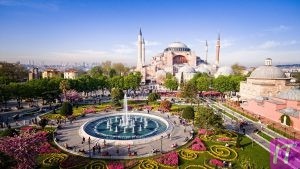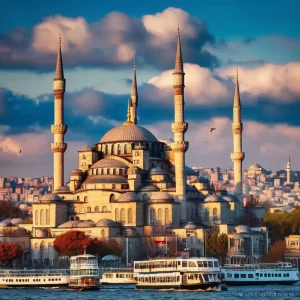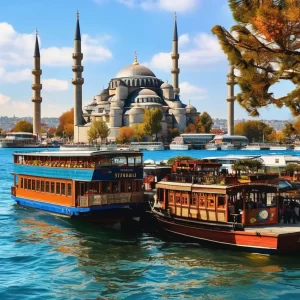Discover the Timeless Charm of Istanbul
Nestled between Europe and Asia, Istanbul stands as a magnificent testament to cultural fusion and historical richness. Visitors are welcomed by a city that exudes an unmistakable vibrancy and charm. From ancient relics to bustling modern markets, Istanbul invites you to uncover its myriad treasures. With its scenic beauty and diverse attractions, it’s no wonder this city has captured hearts for centuries. Here, history meets contemporary lifestyle, offering an enchanting experience to every traveler.
For first-time visitors and seasoned travelers alike, Istanbul promises new adventures each day. The city’s allure lies not only in its famous landmarks but also in its hidden gems waiting to be explored. Embrace the timeless charm of Istanbul and let it captivate your senses with its diverse offerings. From hidden alleyways to majestic palaces, every corner of Istanbul narrates a unique story. Whether you’re strolling through its historic streets or enjoying the panoramic views of its skyline, Istanbul ensures a memorable visit.
One of Istanbul’s primary draws is its ability to effortlessly blend the ancient with the modern. This city is alive with vibrant bazaars, mosque call to prayers, and contemporary art scenes. Its rich mosaic of cultures and histories serves as a backdrop to daily life, making every moment spent in Istanbul feel like a journey through time.
Exploring Istanbul is like peeling back layers of history, with each era leaving its indelible mark on the city’s fabric. The juxtaposition of old and new creates a dynamic atmosphere that is both serene and bustling. Istanbul’s charm is not confined to any single area; it’s spread across its neighborhoods, each offering a distinct flavor and experience.
What sets Istanbul apart is its ability to surprise and enchant at every turn. Despite being a city with over 15 million residents, pockets of tranquility can still be found in its parks, gardens, and along the Bosphorus. Whether you are a history enthusiast, a culinary explorer, or someone seeking spiritual solace, Istanbul has something to offer to everyone.
The hospitality of the locals further adds to the charm of the city. Istanbulites are known for their warmth and friendliness, making tourists feel right at home. Engaging with the locals provides deeper insights into the city’s culture and traditions, enhancing the overall experience.
In essence, Istanbul is not just a city; it’s a living, breathing entity that charms its visitors with its timeless beauty and endless wonders. So, pack your bags and get ready to be spellbound by a city that offers an endless feast for the eyes, soul, and senses.

Exploring the Historic Heart of Istanbul
Istanbul’s historic heart pulsates with stories of empires past, thriving in the Sultanahmet district. This area is a must-visit, being home to some of the city’s most iconic landmarks. Walking through Sultanahmet feels like stepping back in time, with every stone echoing the whispers of history.
Begin your journey with the Hagia Sophia, an architectural marvel that has served as a church, a mosque, and now a museum. This Byzantine wonder impresses with its grandeur and intricate mosaics. Just a stone’s throw away lies the Sultanahmet Mosque, commonly known as the Blue Mosque. Its six minarets and exquisite blue tiles make it a sight to behold.
Adjacent to these landmarks is the ancient Hippodrome, once the sporting and social center of Constantinople. Here, you can find notable monuments like the Serpentine Column and the Obelisk of Theodosius. Istanbul’s rich Roman heritage is palpable in this arena.
Sultanahmet Park offers a serene escape amidst the historic splendor. The park’s lush greenery provides an ideal backdrop for relaxation and contemplation. Further exploration leads to the Topkapi Palace, the opulent residence of Ottoman sultans, boasting an astonishing collection of royal artifacts.
A visit to the underground Basilica Cistern adds a sense of mystery and wonder. This ancient water reservoir with its majestic columns and eerie ambiance is a testament to Roman engineering brilliance. Emerging from the depths, the aroma of Turkish coffee from nearby cafes invites you to relax and savor the flavors of Istanbul.
Do not miss the Museum of Turkish and Islamic Arts, housed in the historic Ibrahim Pasha Palace. The museum showcases a vast collection of artifacts, offering insights into the rich cultural tapestry of Turkey. Pair your explorations with culinary delights at local eateries, savoring dishes that have evolved over centuries.
Conclude your historic tour with the Grand Bazaar, one of the oldest and largest covered markets in the world. Here, you can experience the hustle and bustle, vibrant colors, and tantalizing scents that have enchanted traders for generations.
As you traverse Sultanahmet, take moments to appreciate the layers of time that coexist harmoniously. Each building, each street has its own story, contributing to the majestic narrative of Istanbul’s historic heart.
Top Architectural Wonders in Istanbul
Istanbul is a treasure trove of architectural marvels that reflect its diverse history. From Byzantine to Ottoman, Gothic to Neoclassical, the city’s skyline is a testament to the artistic and engineering feats of various eras.
The Hagia Sophia stands supreme among Istanbul’s architectural wonders. Its massive dome, once the largest in the world, and intricate mosaics offer a glimpse into Byzantine grandeur. Nearby, the Blue Mosque rivals with its six minarets and cascade of domes adorned with over 20,000 hand-painted tiles.
The Topkapi Palace, with its ornate courtyards, pavilions, and harem, exemplifies Ottoman imperial architecture. The palace’s strategic location offers stunning views of the Bosphorus and the Golden Horn, making it an architectural and scenic marvel.
Take a moment to appreciate the architectural finesse of the Dolmabahçe Palace, a striking blend of Ottoman and European styles. Its grandiose façade and opulent interiors, featuring crystal chandeliers and gold leaf accents, are truly breathtaking.
For a taste of Gothic architecture, visit the Church of St. Anthony of Padua on Istiklal Avenue. This Roman Catholic church, with its red-brick façade and rose windows, stands out amidst the hustle and bustle of the modern street.
Modern architecture in Istanbul is equally impressive. The iconic Istanbul Sapphire, Istanbul’s tallest skyscraper, offers an observatory deck that provides panoramic views of the city. The Istanbul Modern Museum, housed in a contemporary building along the Bosphorus, is another highlight, merging art with modern design.
The historic Galata Tower, built by the Genoese in 1348, presents a medieval architectural wonder. From its observation deck, enjoy stunning 360-degree views of Istanbul’s sprawling cityscape. The nearby Galata Bridge offers another architectural interest, bustling with fishermen and offering a unique vantage point.
Architectural exploration in Istanbul leads to the Spice Bazaar as well, known for its vibrant stalls and delightful aromas. The bazaar itself is housed in a structure with a historical blend of function and form. Additionally, the intricate designs of Istanbul’s various hammams (Turkish baths), such as the Süleymaniye Hammam, showcase traditional Ottoman architecture.
Overall, Istanbul’s architectural heritage not only beautifies the city but also tells tales of its rich and varied past. Whether you explore the towering mosques, stately palaces, or modern skyscrapers, you’ll be mesmerized by the craftsmanship and artistry that define Istanbul’s skyline.
Unveiling Istanbul’s Cultural Treasures
The rich cultural tapestry of Istanbul is woven from threads of diverse civilizations, religions, and customs. It is a city where ancient traditions and modern influences coexist harmoniously, creating a unique cultural landscape.
Music is an integral part of Istanbul’s cultural fabric. From the haunting melody of the ney flute to contemporary jazz festivals, the city echoes with diverse musical genres. The iconic Istanbul Music Festival and the Istanbul Jazz Festival attract aficionados from around the globe, offering performances in historic venues that enrich the experience.
Literature also flourishes in Istanbul, inspired by its captivating stories and scenic beauty. Renowned authors like Orhan Pamuk have immortalized the city in their works. A visit to the Museum of Innocence, inspired by Pamuk’s novel, offers a unique literary journey through Istanbul’s past.
The city’s artistic scene is vibrant and dynamic. The Istanbul Biennial, one of the most prestigious contemporary art exhibitions, showcases cutting-edge works from international artists. Numerous galleries, such as the Istanbul Modern and Pera Museum, serve as creative hubs, reflecting the city’s artistic spirit.
Theater and performing arts thrive in Istanbul. The city is home to a range of venues, from the historic Atatürk Cultural Center to contemporary stages like the Zorlu Performing Arts Center. These venues host a diverse array of performances, including opera, ballet, and theatrical productions.
Traditional Turkish arts, such as calligraphy and ebru (paper marbling), are cherished and preserved in Istanbul. Workshops and exhibitions provide opportunities for locals and tourists alike to appreciate and learn these ancient crafts. The Turkish Calligraphy Art Museum is a repository of this delicate and expressive art form.
Culinary traditions are another vital aspect of Istanbul’s cultural treasures. The city’s food scene is a delightful fusion of flavors, reflecting its cross-continental heritage. From sumptuous kebabs to delectable baklava, Istanbul offers a gastronomic journey that tantalizes the taste buds. Culinary tours and cooking classes provide immersive experiences for food enthusiasts.
Istanbul’s cultural landscape is further enriched by its festivals and celebrations. Events like the Istanbul Film Festival, the Beyoğlu Culture Road Festival, and the International Tulip Festival bring the city to life with vibrant colors, sounds, and activities. These festivals celebrate Istanbul’s heritage and contemporary culture, fostering a sense of community and joy.
Understanding Istanbul’s cultural treasures also involves exploring its diverse neighborhoods. Each district has its unique personality and charm, offering insights into the everyday life and traditions of its residents. Engaging with local communities and their customs provides a deeper appreciation of the city’s rich cultural heritage.
As you explore Istanbul’s cultural treasures, you’ll find that the city’s spirit is reflected in its people, art, music, and traditions. It’s a journey that deepens your connection to Istanbul and leaves you with lasting memories of a truly enriching experience.

Istanbul’s Best Neighborhoods to Visit
Istanbul’s neighborhoods each have a distinctive character and charm, offering different facets of the city to explore. From historic quarters to vibrant cultural hubs, Istanbul’s districts present a rich tapestry of experiences.
Start with Sultanahmet, the historic heart of Istanbul. Here, the majestic Hagia Sophia, Blue Mosque, and Topkapi Palace dominate the skyline, offering a deep dive into Byzantine and Ottoman history. Wander through its cobbled streets and relish the ambiance of a bygone era.
Beyoğlu, centered around Istiklal Avenue, is known for its bohemian atmosphere and vibrant nightlife. The famous Galata Tower offers panoramic views of Istanbul, while numerous cafes, art galleries, and boutiques line the streets, creating a lively and artistic vibe.
Kadıköy, located on the Asian side, provides a more relaxed and local experience. This neighborhood is known for its bustling markets, diverse food scene, and waterfront promenade. The Kadıköy Market is a food lover’s paradise, offering fresh produce, seafood, and local delicacies.
Balat and Fener, two adjacent neighborhoods, are steeped in history and culture. Once home to Istanbul’s Greek and Jewish communities, these areas are rich with colorful houses, historic churches, and synagogues. Their narrow streets invite leisurely strolls and offer photographers a visual feast.
Nişantaşı is the epitome of modern luxury in Istanbul. Known for its upscale shopping, fine dining, and chic cafes, Nişantaşı is where the city’s elite come to see and be seen. Designer boutiques and international brands make it a top destination for fashion enthusiasts.
Moda, another charming neighborhood on the Asian side, is known for its laid-back and artistic ambiance. With its tree-lined streets, quaint cafes, and stunning views of the Sea of Marmara, Moda offers a tranquil escape from the bustling city center.
Ortaköy, located along the Bosphorus, is famous for its picturesque mosque, lively market, and waterfront cafes. It’s a favorite spot for locals and tourists alike to enjoy traditional kumpir (stuffed baked potatoes) while taking in the stunning views of the Bosphorus Bridge.
Beşiktaş is a bustling neighborhood known for its vibrant food scene, bustling market, and lively atmosphere. The Beşiktaş Fish Market is a must-visit for seafood lovers, while the Barbaros Square offers a lively gathering spot for locals.
Üsküdar, on the Asian side, showcases Istanbul’s traditional and serene side. Iconic landmarks like the Maiden’s Tower and beautiful mosques like the Mihrimah Sultan Mosque grace this neighborhood, providing a peaceful and contemplative atmosphere.
Each of Istanbul’s neighborhoods offers a unique perspective of the city, reflecting its rich history, diverse culture, and dynamic lifestyle. Exploring these districts allows you to experience the true essence of Istanbul and its multifaceted charm.
Iconic Landmarks That Define Istanbul
Istanbul’s skyline is punctuated by iconic landmarks that narrate the city’s storied past and vibrant present. These structures stand as timeless symbols of Istanbul’s rich cultural and historical tapestry.
The Hagia Sophia, perhaps Istanbul’s most celebrated landmark, epitomizes the city’s historical and architectural grandeur. Its colossal dome, stunning mosaics, and rich history as a cathedral, mosque, and now museum, make it a must-visit.
Another unmissable site is the Blue Mosque, or Sultanahmet Mosque, famed for its striking blue tiles and impressive six minarets. Its presence opposite the Hagia Sophia creates a breathtaking visual harmony in Istanbul’s historic heart.
Topkapi Palace, the opulent abode of Ottoman sultans, offers a glimpse into royal life with its elaborate courtyards, rich collections of artifacts, and stunning views over the Bosphorus. The palace’s imperial architecture and lush gardens make it an architectural wonder.
The Grand Bazaar is one of the world’s oldest and largest covered markets. With over 4,000 shops selling everything from spices to jewelry, it encapsulates the bustling commercial spirit of Istanbul.
Galata Tower, a medieval stone tower, provides one of the best panoramic views of Istanbul. Climbing its staircase or taking the elevator rewards visitors with a stunning vista of the city and its waterways.
For a serene escape, visit Yildiz Park and the adjoining Yıldız Palace. This vast parkland and former imperial residence offer picturesque gardens, pavilions, and stunning Bosphorus views, perfect for leisurely strolls.
Dolmabahçe Palace, another Ottoman masterpiece, stuns with its blend of European styles. Its opulent halls, crystal chandeliers, and lavish rooms exemplify Ottoman grandeur and luxury.
The Basilica Cistern, an ancient underground water reservoir, adds a touch of mystery to Istanbul’s charm. Its forest of columns, illuminated by eerie lights, creates a surreal and enchanting atmosphere.
For a slice of history and spirituality, visit the Suleymaniye Mosque, built by the famed architect Sinan. This mosque not only stands as an architectural marvel but also provides a tranquil sanctuary amidst the bustling city.
The Maiden’s Tower, located on a small islet in the Bosphorus, is shrouded in legends and offers a picturesque spot for sunset views. This iconic structure has served various purposes over centuries, adding to its mystique.
Taksim Square, though modern, holds great significance as the epicenter of political and social activities. Nearby is the historic Ataturk Cultural Center, an important cultural landmark currently under restoration.
Each of these landmarks contributes to the rich mosaic that defines Istanbul, making it a city where every corner has a story to tell and a memory to create. Exploring these iconic sites offers a deep and enriching connection to Istanbul’s multifaceted heritage.

A Journey Through Istanbul’s Ancient Past
Istanbul’s ancient past is a rich tapestry woven from various civilizations and empires that have left indelible marks on the city’s landscape. From Byzantium to Constantinople, and now Istanbul, each era has contributed to its storied heritage.
The ancient city of Byzantium, founded by Greek settlers, laid the foundation for Istanbul’s strategic significance. Located at the crossroads of Europe and Asia, it became a thriving hub for trade and cultural exchange. Remnants of this era can be seen in the ancient city walls and archeological sites.
When Emperor Constantine the Great made Byzantium the new capital of the Roman Empire, renaming it Constantinople, the city began to flourish as a center of art, culture, and religion. The construction of the Hippodrome, Hagia Sophia, and the Great Palace marked this golden age.
The Byzantine era saw the rise of significant religious and architectural landmarks. The Hagia Sophia, constructed under Emperor Justinian, stood as the world’s largest cathedral for nearly a thousand years, symbolizing Byzantine architectural brilliance and religious significance.
The conquest of Constantinople by the Ottoman Empire in 1453 marked a new chapter in Istanbul’s history. Sultan Mehmed the Conqueror transformed the city into a thriving Ottoman capital, introducing Islamic culture and architecture. The transformation of Hagia Sophia into a mosque was a symbolic act of this new era.
The Ottomans enriched Istanbul with majestic mosques, palaces, and gardens. The Topkapi Palace, constructed by Mehmed the Conqueror, became the seat of the Ottoman sultans, showcasing opulence and administrative prowess.
The Süleymaniye Mosque, built by the great architect Sinan, stands as a testament to the architectural and artistic achievements of the Ottoman era. Sinan’s works, including the smaller yet equally impressive Rüstem Pasha Mosque, add to Istanbul’s architectural splendor.
The Byzantine Chora Church, with its exquisite mosaics and frescoes, and the underground Basilica Cistern highlight the engineering and artistic achievements of ancient Istanbul. These landmarks provide a window into the city’s early Christian heritage.
The Grand Bazaar and Spice Bazaar, established during the Ottoman period, became bustling centers of trade, drawing merchants from all corners of the world. These markets remain vibrant and essential parts of Istanbul’s cultural landscape.
Exploring Istanbul’s ancient past also involves visiting its lesser-known archeological sites, like the Theodosian Walls, a defense system that protected Constantinople for centuries. These walls and gates, though partially in ruins, evoke the grandeur of the city’s fortifications.
As a melting pot of civilizations, Istanbul’s ancient past is also reflected in its diverse religious heritage. The city boasts numerous churches, synagogues, and mosques, each narrating tales of the communities that built and worshipped in them.
Istanbul’s ancient past is a journey through time, revealing the layers of history that have shaped its present. From ancient ruins to majestic monuments, each site provides a deeper understanding of the city’s evolution and enduring legacy.

Stunning Views from Istanbul’s Galata Tower
Galata Tower, a symbol of medieval Istanbul, offers some of the most stunning panoramic views of the city. Standing tall in the Galata district, this tower is not only an architectural marvel but also a vantage point providing breathtaking vistas over Istanbul.
Built in the 14th century by the Genoese, Galata Tower has served various purposes throughout history, including as a lookout tower, fire tower, and even a dungeon. Today, it welcomes visitors who climb its heights to enjoy unparalleled views.
Ascending the tower, either by stairs or elevator, anticipation builds with each step. Upon reaching the observation deck, visitors are rewarded with a 360-degree view that captures the essence of Istanbul’s diverse landscape.
To the east, the historic peninsula of Sultanahmet comes into view. The majestic silhouettes of the Hagia Sophia and the Blue Mosque dominate the skyline, with the Topkapi Palace nestled nearby. This vista encapsulates the rich history and architectural grandeur of ancient Istanbul.
Looking north, the bustling Beyoğlu district unfolds below, with Istiklal Avenue stretching out towards Taksim Square. The vibrant







